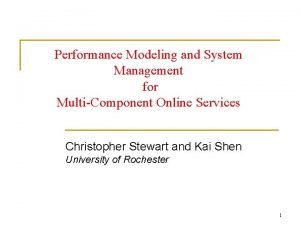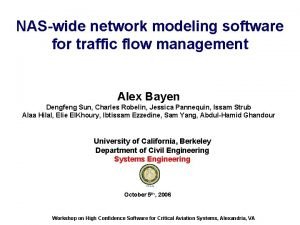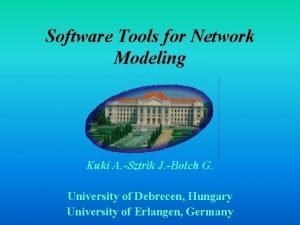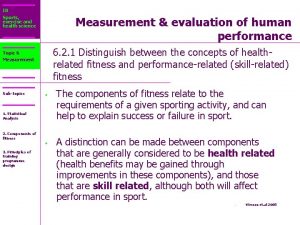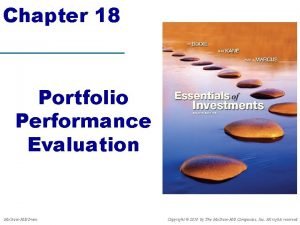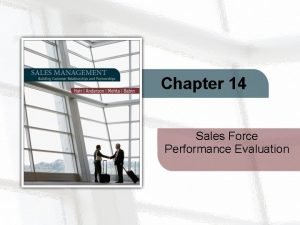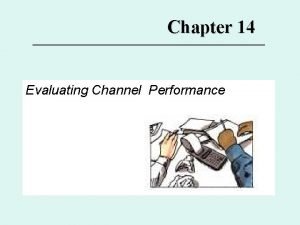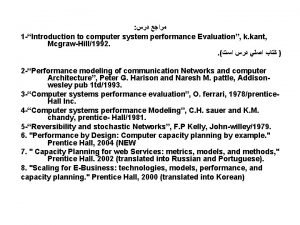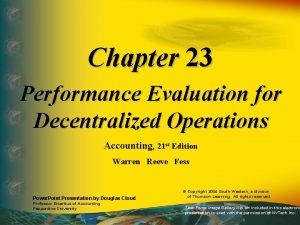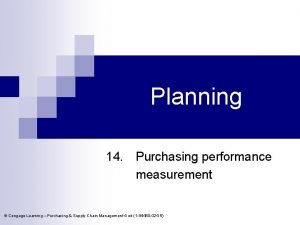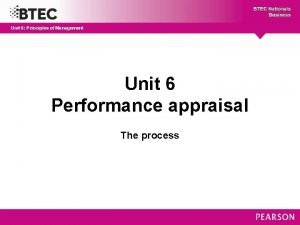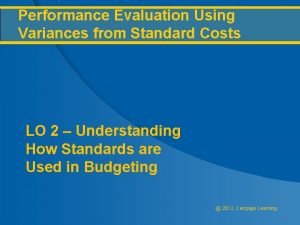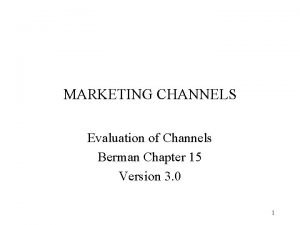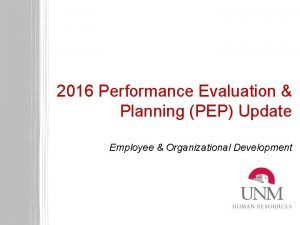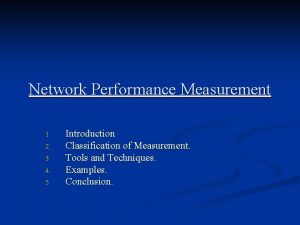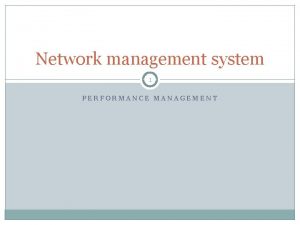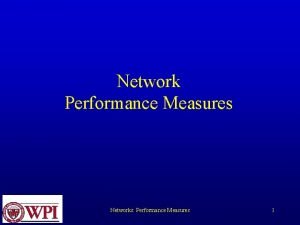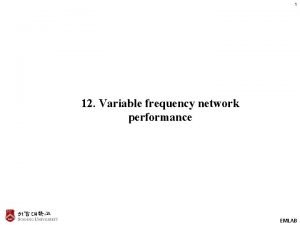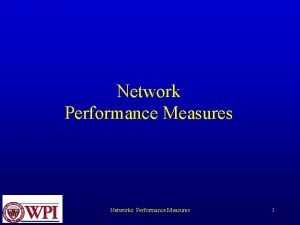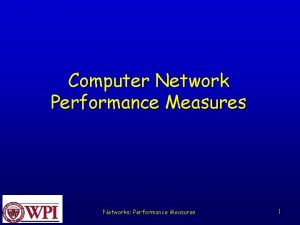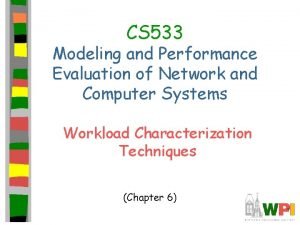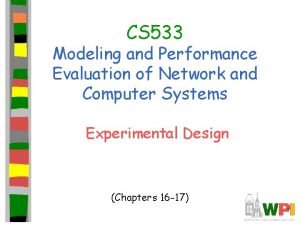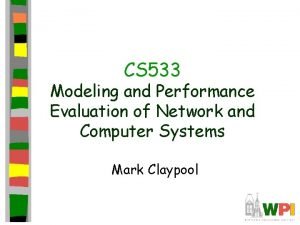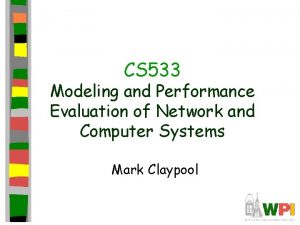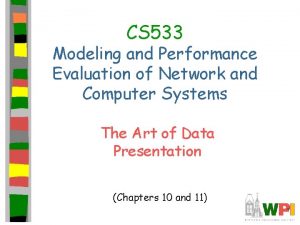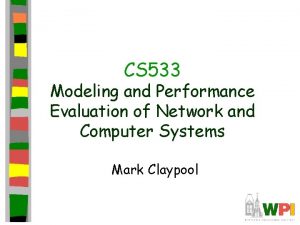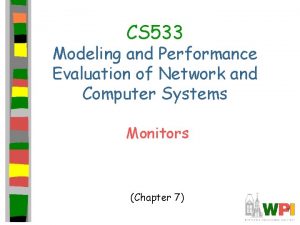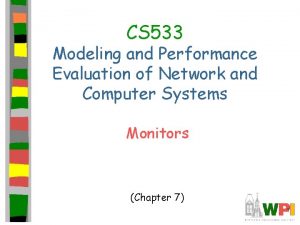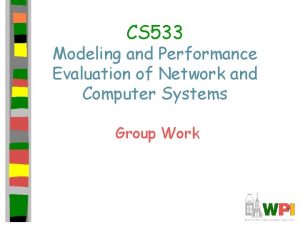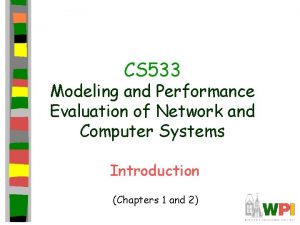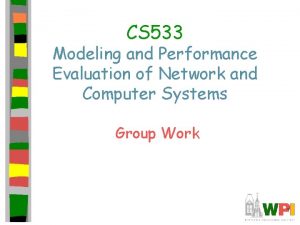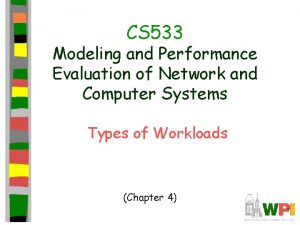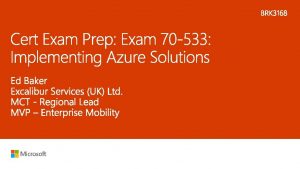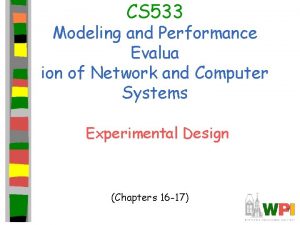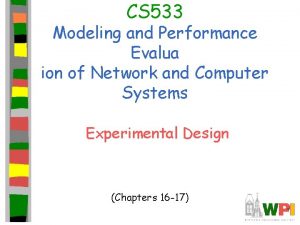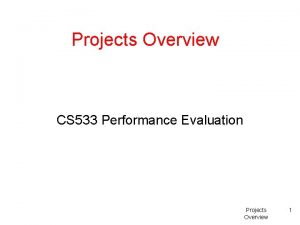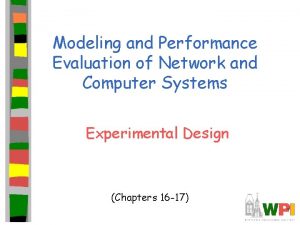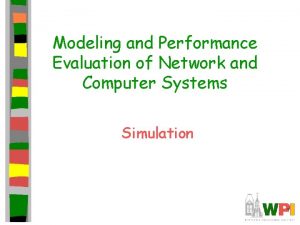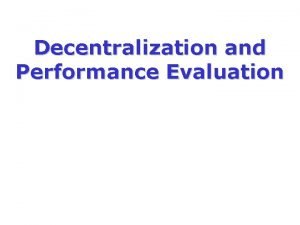CS 533 Modeling and Performance Evaluation of Network



















































- Slides: 51

CS 533 Modeling and Performance Evaluation of Network and Computer Systems Queuing Theory (Chapter 30 -31) 1

Introduction “It is very difficult to make accurate predictions, especially about the future. ” - Niels Bohr • In computers, jobs share many resources: • • CPU, disks, devices Only one can access at a time, and others must wait in queues Queuing theory helps determine time jobs spend in queue – Can help predict response time 2

Outline • Introduction • Notation and Rules • Little’s Law • Types of Stochastic Processes • Analysis of a Single Queue, Single Server • Analysis of a Single Queue, Multiple Servers 3

Notation (1 of 4) • Queue Customer Population • • 4 Servers Imagine waiting for a PC in the computer lab (or checking out at a grocery store, or …) – Resources are “servers” – People are “customers” If all servers busy, customers wait in a “queue” For queuing analysis, need to specify: – – – Population size Number of servers System capacity Arrival process Service time distribution – Service discipline

Notation (2 of 4) • Number of servers • System capacity Queue • 5 Customer Population size – Potential customers who can enter – Most real systems finite but easier to analyze if infinite – Can be one or more – Assume identical, but if not then separate queuing system for each – Number that can wait plus be served – Most systems have finite queue length, but easier to analyze if infinite

Notation (3 of 4) • Arrival Process Queue • Customer Population Arrival process – Students arrive a t 1, t 2, …, tj – Interarrival times are j=tj-tj-1 – Usually assume independent, identically distributed (IID) 6 Arrival process (cont. ) – Most common are Poisson arrivals • IID and exponentially • distributed (f(x)= e- x) Service time distribution – Amount of time each customer at server – Again, usually IID – Most common are exponential

Notation (4 of 4) • ? Queue Servers • Service discipline – Order customers called for servicing – Most common is FCFS • Kendall notation – A/S/m/B/K/SD – A is Arrival time distro – S is Service time distro – m is number of servers – B is number of buffers – K is population size – SD is service discipline Some typical times used: – M Exponential • M means “memoryless” in that current arrival independent of past – D Deterministic – G General 7 • Valid for all

Notation Example • M/M/3/20/1500/FCFS – single queue system with: – – – Exponentially distributed arrivals Exponentially distributed service times Three servers Capacity 20 (queue size is 20 – 3 = 17) Population is 1500 total Service discipline is FCFS • Often, assume infinite queue and infinite population and FCFS, so just M/M/3 8

Variables for All Queues Queue Previous arrival • • 9 Time Arrival w = interarrival time = mean arrival rate – = 1/E[ ] – Can sometimes depend upon jobs in system s = service time per job = mean service rate per server – = 1/E[s], total rate m Begin Servers End Service • • • s nq = number of jobs waiting in queue ns = number of jobs receiving service n = number of jobs in system – n = nq + n s r = response time w = waiting time Note, all except and are random

Rules for All Queues (1 of 4) • Stability Condition – If the number of jobs becomes infinite, system unstable. For stability, mean arrival rate less than mean service rate < m – Does not apply to finite queue or finite population systems • Finite population cannot have infinite queue • Finite queue drops if too many arrive so never has infinite queue 10

Rules for All Queues (2 of 4) • Number in System versus Number in Queue – Number of jobs is equal to waiting and servicing – Also means: • n = nq + n s E[n] = E[nq]+E[ns] – So mean number of jobs is equal to mean number in queue plus mean number being serviced Var[n] = Var[nq]+Var[ns] – Variance of jobs equal to variance of queue + svc Also, service rate of servers independent of jobs in queue Cov(nq, ns) = 0 11

Rules for All Queues (3 of 4) • Number versus Time – If jobs not lost due to buffer overflow the mean jobs is related to response time as: mean jobs in system = arrival rate x mean response time – Similarly mean jobs in queue = arrival rate x mean waiting time – Above equations known as “Little’s Law” (derivation in 30. 3, next) – For finite buffers can use effective arrival rate (ignoring drops) 12

Rules for All Queues (4 of 4) • Time in System versus Time in Queue – Time spent in system is sum of queue and service time r=w+s – In particular: E[r] = E[w] + E[s] – If service rate independent of jobs in queue Cov(w, s) = 0 Var[r] = Var[w] + Var[s] 13

Outline • Introduction • Notation and Rules • Little’s Law • Types of Stochastic Processes • Analysis of a Single Queue, Single Server • Analysis of a Single Queue, Multiple Servers 14

Little’s Law (1 of 2) Mean jobs in system = arrival rate x mean response time • • • Very commonly used in theorems Applies if jobs entering equals jobs serviced – No new jobs created, no new jobs lost – If lost, can adjust arrival rate to mean only those not lost Intuition: suppose monitor system and keep log of arrival and departures. If long enough, arrivals about the same as departures. – Let there be N arrivals in long time T. Then: arrival rate = total arrivals / total time = N/T 15

Little’s Law (2 of 2) • Can plot data gathered in 3 ways (Fig 30. 4 a-c) • Area in each is same, call it J • 30. 4 c mean time in system = J/N • 30. 4 b mean number in system is J/T – Multiply by N/N: = N/T x J/N = arrival rate x mean time in system Little’s Law 16

Applying Little’s Law • Can be applied to subsystem, too • Example: 17 – mean time in queue = arrival rate x waiting time – mean time being serviced = arrival rate x service time – server satisfies I/O request in average of 100 msec. I/O rate is about 100 requests/sec. What is the mean number of requests at the server? – Mean number at server = arrival rate x response time = (100 requests/sec) x (0. 1 sec) = 10 requests

Outline • Introduction • Notation and Rules • Little’s Law • Types of Stochastic Processes • Analysis of a Single Queue, Single Server • Analysis of a Single Queue, Multiple Servers 18

Types of Stochastic Processes (1 of 5) • Number of jobs at CPU of computer system • at time t is a random variable (n(t)) To specify such random variables, need probability distribution function for each t – Same with waiting time (w(t)) • These random functions of time or • 19 sequences are called stochastic processes Useful for describing state of queuing systems

• Types of Stochastic Processes (2 of 5) Discrete-State and Continuous-State Process – Depends upon values its state can take – If finite or countable discrete – Ex: jobs in system n(t) can only take values 0, 1, 2 … countable, so discrete-state process • Also called a stochastic chain • 20 – Ex: waiting time w(t) can take any real value, so continuous-state process Markov Process – If future states depend only on the present and are independent of the past then called markov process – Makes it easier to analyze since do not need past trajectory, only present state – Also memory-less in that don’t need length of time in current state

• Types of Stochastic Processes (3 of 5) Birth-Death Process – Markov in which transitions restricted to neighboring states only are called birth-death process – Can represent states by integers, s. t. process in state n can only go to state n+1 or n-1 – Ex: jobs in queue with single server can be represented by birth-death process • Arrival (birth) causes state to change by +1 and • 21 departure after service (death) causes state to change by – 1 Only if arrive individually, not in batch

Types of Stochastic Processes (4 of 5) • Poisson Processes – If interarrival times are IID and exponentially distributed, then number of arrivals over interval [t, t+x] has a Poisson distribution Poisson Process – Popular because arrivals are memoryless – Also: • Merging k Poisson streams with mean rate i gives another Poisson stream with mean rate: = i (See Figure 30. 6 a) 22

Types of Stochastic Processes (4 of 5) • Poisson Processes (continued) – Also • If Poisson stream split into k substreams with probability pi, each substream is Poisson with mean rate pi (Figure 30. 6 b) • If arrivals to single server with exponential service times are Poisson with mean , departures are also Poisson with mean , if ( < ) (Figure 30. 6 c) – Same relationship holds for m servers as long as total arrival rate less than total service rate (Figure 30. 6 d) 23

Types of Stochastic Processes (5 of 5) Markov Processes Birth-death Processes Poisson Processes 24

Questions • M/D/10/5/1000/LCFS – What can you say about it? – What is bad about it? • Which has better performance: • M/M/3/300/100 or M/M/3/100? During 1 hour, name server received 10, 800 requests. Mean response time 1/3 second. – What is the mean number of queries in system? 25

Utilization Law (should be slide 18) • • • 26 Given average arrival rate . Average utilization of a system is time busy over total time Factor into: U = b/T = (b/d) (d/T) where d is number of departures and arrivals during time T Notice, (b/d) is average time spent servicing each of the d jobs. Call it s (s = b/d) Since balanced (in == out), = d/T So: U = s (Utilization Law)

Applying Utilization Law • Consider I/O system with one disk and one • • controller. If average time required to service each request is 6 msec, what is maximum request rate it can tolerate? Maximum will occur when 100% utilized, so U=1 Substituting U = s, we get: 1 = maxs • So, max= 1 / (6 x 10 -3) = 167 requests/sec 27

Utilization Law • Notice, utilization law U= s can be written as: • where is the average service rate Ratio / is often called traffic intensity • • 28 U = / – Given own symbol = / If ( > 1) then > (arrival rate greater than service rate) – Jobs arrive faster than can be processed – Queue grows to infinity – Unstable Must have ( < 1) for stability (so U never > 100%)

Operational Analysis • • 29 Using Little’s Law and Utilization Law can say things about average behavior – Requires no assumptions about distribution times of arrivals or servicing – High level view But can not say things about, say, maximum or worst case For example, cannot use it to determine needed buffer space to enqueue incoming requests Will use stochastic distributions and queuing theory to get more detailed analysis

Outline • Introduction • Notation and Rules • Little’s Law • Types of Stochastic Processes • Analysis of a Single Queue, Single Server • Analysis of a Single Queue, Multiple Servers 30

Single Queue, Single Server M/M/1 Queue (1 of 6) • Only one queue, exponentially distributed arrivals and service time – Ex: CPU in a system, processes in queue • No buffer or population limitations • Can often be modeled as birth-death process – Jobs arrive individually (not batch) – Changes state to n+1 (birth), n-1 (death) • Transitions depend only on current state 0 31 1 … 2 Notation: probability of being in state n is Pn

Single Queue, Single Server M/M/1 Queue (2 of 6) • At any state, probability of going up same as probability coming down (balanced) Pn-1 = Pn, or Pn = ( / )Pn-1 = Pn-1 • We have: P 1 = P 0, P 2 = P 1, . . • In general, probability of exactly n jobs in the system is: P n = n. P 0 • We want a closed form for Pn (with no P 0) 32

Single Queue, Single Server M/M/1 Queue (3 of 6) • All probabilities add to 1, so: Pn = n. P 0 = 1 • Expanding: n=0, 1, …, 0 P 0 + 1 P 0 + 2 P 0 + … = 1 P 0 = 1 / ( 0+ 1+ 2…) = 1/ n • Since < 1 for stability, can be shown that • 33 sum converges: P 0 = 1 - and Pn = (1 - ) n Can now derive many useful performance parameters for M/M/1 queue

Single Queue, Single Server M/M/1 Queue (4 of 6) • Mean jobs in system • Variance of jobs in system • Probability of n or more jobs • Mean response time E[n] = n. Pn = n(1 - ) n = 1/(1 - ) n=0, …, Var[n] = E[(n – E[n])2] = E[n 2] - (E[n])2 2 n 2(1 - ) n – ( n(1 - ) n)2 = /(1 - )2 Pr ( n jobs in system) = Pj = (1 - ) j = n j=n, …, – Using Little’s law • mean jobs = mean arrv rate x mean resp time E[n] = E[r] = E[n]/ = ( /(1 - ))(1/ ) = (1/ ) / (1 - ) 34

Single Queue, Single Server M/M/1 Queue (5 of 6) • Mean jobs in queue (use n-1 since at most one serviced) E[nq] = (n-1)Pn = (n-1)(1 - ) n = 2/(1 - ) – When no jobs in system, idle – When jobs in system, busy • Utilization – Server is busy when 1 or more jobs in system – Average load, or average utilization U = 1 – P 0 = 1 -(1 - ) = – (Note, same as before) 35

• • Single Queue, Single Server M/M/1 Queue (6 of 6) As utilization increases beyond 85%, queue rises sharply – Corresponding sharp rise in response time Utilization must be under 100%, but often lower – Ex: OS CPU scheduler often has 60 -80% heuristic 36

Example of M/M/1 Queue Analysis (1 of 2) • Network gateway, 4 Mbps, packet size 1000 bytes, Arrival rate of 125 packets/sec – What is the probability of overflow with only 12 buffers? – How many buffers are needed to keep packet loss to 1 in 1, 000? 37

Example of M/M/1 Queue Analysis (2 of 2) • Arrival rate =125 pps • Probability of n packets in gateway • Service rate: n n • • 4000000/8 = 500000 Mbytes/sec 500000/1000 = 500 pps So, =500 pps Utilization (traffic intensity): = / = 125/500 =. 25 Mean packets in gateway: /(1 - ) =. 25/. 75 =. 33 38 Pr(n) = (1 - ) =. 75(. 25) • Mean time in gateway: • Prob of overflow = Pr(13+) • To limit to less than 10 -6 (1/ ) / (1 - ) = (1/500)/(1 -. 25) = 2. 66 ms = 13 =. 2513 = 1. 49 x 10 -8 15 packets/billion n 10 -6 n > log(10 -6)/log(. 25) > 9. 96 – So, 10 buffers

Another Example of M/M/1 Queue Analysis (1 of 2) • Web server. Time between requests exponential with mean time between 8 ms. Time to process exponential with average service time 5 ms. A) What is the average response time? B) How much faster must the server be to halve this average response time? C) How big a buffer so only 1 in 1, 000, 000 requests are lost? 39

Another Example of M/M/1 Queue Analysis (2 of 2) • Request rate = 1000 / 8 = 0. 125 requests per ms • Service rate • Utilization = 1000 / 5 = 0. 2 requests per ms = / =. 125/. 2 =. 625 – So, 62. 5% of capacity A) Avg response time (1/ ) / (1 - ) = (1/. 2)/(1 -. 625) = 13. 33 ms 40 • • To halve, want (1/ ) / (1 - ) = 6. 665 – Assume fixed, so change = 1/6. 665 + 0. 125 =. 257 B) So, (. 275 -. 2)/. 2 * 100 = 37. 5% faster 1 in 1 billion errors – Buffer size k: Pr(k) 10 -9 k 10 -9 C) So, k > log(10 -9) / log(. 625) k 44

Outline • Introduction • Notation and Rules • Little’s Law • Types of Stochastic Processes • Analysis of a Single Queue, Single Server • Analysis of a Single Queue, Multiple Servers 41

• Single Queue, Multiple Servers M/M/c Queue (1 of 4) Model multiple servers – Model multiprocessor (SMP) systems • All “ready to run” processes in one queue • • • 42 – Model Web server “farm” – Model grocery store with single queue ‘c’ is the number of servers (Jain uses ‘m’) Assume arrival rate is the same Each server now can serve jobs per time – Mean service rate c – Note, assumes no “cost” for determining server If any server idle (fewer than c jobs in system, say n), job serviced immediately If all c servers are busy, job waits in queue

Single Queue, Multiple Servers M/M/c Queue (2 of 4) 0 1 • • • 43 … 2 2 3 c … c+1 c+2 (c-1) From above: n=0, …, n=n n=1, …, c-1 n=c, …, Using balanced equations: Pn = [(c )n/n!]P 0 n=1, …, c Pn = [(c )n/(c!cn-c)]P 0 n>c Where is traffic intensity – Also, utilization of each server c • • • c c Find P 0 since sum must be 1 Pn= [(c )n/n!]P 0 (1 to c) + [(c )n/(c!cn-c)]P 0 (c+1 to ) =1 Solve for P 0 = _____1_____ [(c )n/n!] + (c )c/(c!(1 - )) (n=1 to c in first term)

Single Queue, Multiple Servers M/M/c Queue (3 of 4) • Newly arriving job will wait if all servers are busy. Happens if more than c jobs. Pr(>c jobs) = c+ c+1+ c+2+… = Pn (n from c+1 to ) = P 0(c )c/c! x n-c (n from c+1 to ) = [(c )c]/[c!(1 - )] P 0 – Known as Erlang’s C formula ( ) • Mean jobs in system E[n] = n. Pn = [P 0(c )c]/[c!(1 - )2] + c = c + /(1 - ) 44

Single Queue, Multiple Servers M/M/c Queue (4 of 4) • Mean jobs in queue E[nq] = (n-c)Pn = P 0(c )c/c! x (n-c) n-c = [P 0 (c )c]/[c!(1 - )2] = /(1 - ) • Mean response time – Using Little’s law • mean jobs = mean arrv rate x mean resp time E[n] = E[r] = E[n]/ E[r] = 1/ + /[c (1 - )] • Mean waiting time E[w] = E[nq]/ = [ /(1 - )]/ = /[c (1 - )] 45

M/M/c Example (1 of 2) • How does response time for previous M/M/1 Web server change if number of servers increased to 4? – Can model as M/M/4 46

M/M/c Example (2 of 2) • • • 47 Request rate =0. 125 Service rate =0. 2 Traffic intensity – = /(c ) = 0. 1563 Probability of idle P 0 = ____1_____ [(c )n/n!] + (c )c/(c!(1 - )) P 0 = 0. 532 • • • Erlang’s C formula – = (4 x 0. 1563)4 (0. 5352) 4!(1 -. 01563) =. 0040326 So, average response time: E[r] = 1/ + /c (1 - ) = 1/. 2 +. 004326/(4)(. 2)(1. 1563) = 5. 01 ms Thus, increasing servers by 4 reduces response time by appx 62%

Another M/M/c Example (1 of 2) • Students arrive at computer lab, 10 per hour. Spend 20 minutes at a terminal (assume exponentially distributed) and then leave. Center has 5 terminals. A) How many terminals can go down and still be able to service the students? B) What is the probability all terminals are busy? C) How long is the average student in center? 48

Another M/M/c Example (2 of 2) • • Arrival rate =. 167 per min, =. 05 per min Utilization = /( c) =. 167/(. 05 x 5) =. 67 A) Find c s. t. U > 1, so 1 > /( c) c > /u 4 • – One terminal only can go down Prob all idle, P 0 = [1 + (5 x. 67)5/[5!(1 -. 67)] + (5 x. 67)1/1! + (5 x. 67)2/2! + (5 x. 67)3/3! + + (5 x. 67)4/4!]-1 = 0. 0318 B) Prob busy Erlang’s C formula ( ) Pr(>c jobs) = [(cp)c]/[c!(1 - )] P 0 = [(5 x. 67)5] / [5!(1 -. 67)] x. 0318 =. 33 – So, 1/3 of the time you’ll need to wait upon arriving C) Time to wait: E[w] = /[m (1 - )] 49 =. 33/(5 x. 05 x(1 -. 67)) = 4 minutes

M/M/c versus M/M/1 (1 of 2) • Consider what would happen if the terminals were distributed in separate labs, one per lab, across campus. A) Would you wait longer? • Can model as separate M/M/1 systems and compare to M/M/c system 50

M/M/c versus M/M/1 (2 of 2) • For M/M/1 =. 167 / 5 =. 0333 and =. 05 – =. 0333/. 05 =. 67 • Expected waiting time: E[w] = E[nq]/ = [ 2 / (1 - )] / = [(. 67)2/(1 -. 67)] / (. 033) 41 minutes A) Yes. A lot longer. • What is the model ignoring that may make the answer seem better? 51
 Bf-533
Bf-533 Model and role modeling theory
Model and role modeling theory Relational vs dimensional data modeling
Relational vs dimensional data modeling Progress and performance measurement and evaluation
Progress and performance measurement and evaluation Evaluation in progress
Evaluation in progress Performance modeling
Performance modeling Network modeling software
Network modeling software Network modeling tools
Network modeling tools Measurement and evaluation in human performance 5e download
Measurement and evaluation in human performance 5e download Vertical jump adalah
Vertical jump adalah Computer architecture performance evaluation methods
Computer architecture performance evaluation methods Portfolio performance evaluation problems
Portfolio performance evaluation problems Evaluating sales performance
Evaluating sales performance Importance of evaluating channel member performance
Importance of evaluating channel member performance Computer system performance
Computer system performance Oscd usmc
Oscd usmc Direct support professional performance evaluation
Direct support professional performance evaluation Performance evaluation for decentralized operations
Performance evaluation for decentralized operations Purchasing performance evaluation
Purchasing performance evaluation Citibank performance evaluation
Citibank performance evaluation Housekeeping items for meetings
Housekeeping items for meetings Unit 6 principles of management sample answers
Unit 6 principles of management sample answers Stronge leader effectiveness performance evaluation model
Stronge leader effectiveness performance evaluation model Performance evaluation using variances from standard costs
Performance evaluation using variances from standard costs Library staff performance evaluation
Library staff performance evaluation Channel performance evaluation
Channel performance evaluation Performance evaluation model
Performance evaluation model Chra europe region employment
Chra europe region employment Pep performance evaluation
Pep performance evaluation Vc vs datagram
Vc vs datagram Features of peer to peer network and client server network
Features of peer to peer network and client server network Network centric computing
Network centric computing Behaviorally anchored rating scale
Behaviorally anchored rating scale Disadvantages of bell curve in performance appraisal
Disadvantages of bell curve in performance appraisal Jcids process
Jcids process Decision trees show the logic structure in a
Decision trees show the logic structure in a Linear quadratic function
Linear quadratic function Describe data and process modeling concepts and tools
Describe data and process modeling concepts and tools Network performance measurement tools
Network performance measurement tools Network performance management functions
Network performance management functions Tppen
Tppen Network performance measurement
Network performance measurement Network performance measurement tools
Network performance measurement tools Network performance variables
Network performance variables Network performance measurement in computer networks
Network performance measurement in computer networks Performance metrics in computer networks
Performance metrics in computer networks Topology in computer
Topology in computer Network systems design using network processors
Network systems design using network processors Advantage and disadvantages of packet switching
Advantage and disadvantages of packet switching Simulation kelton
Simulation kelton Sequential decision analytics and modeling
Sequential decision analytics and modeling Log to exponential form
Log to exponential form





